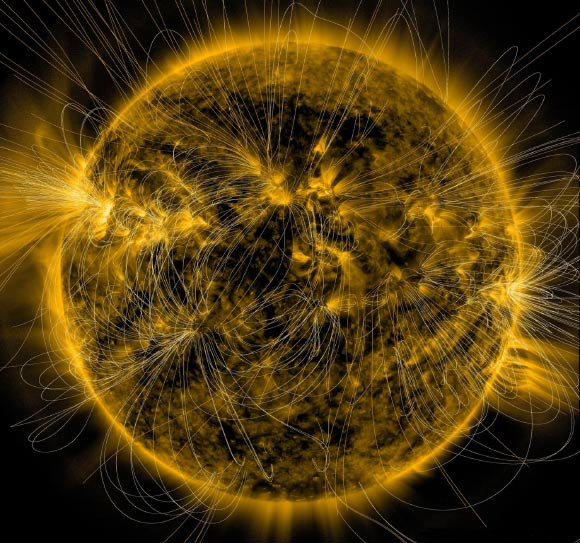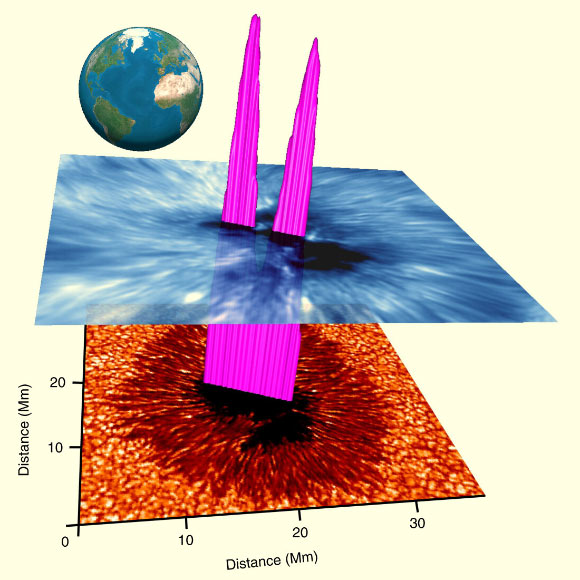Researchers Crack Mystery of Sun’s Magnetic Waves | Astronomy – Sci-News.com
For more than six decades, observations of our Sun have shown that as magnetic waves leave its interior they grow in strength, but until now there has been no solid observational evidence as to why this was the case.

SDO image of the solar corona in UV light (yellow lines represent the magnetic field on the surface of the Sun). Image credit: NASA / SDO / AIA / LMSAL.
Usually the closer we are to a heat source, the warmer we feel. However, this is the opposite of what seems to happen on the Sun — its outer layers are warmer than the heat source at its surface.
Solar astronomers have accepted for a long time that magnetic waves channel energy from the Sun’s vast interior energy reservoir, which is powered by nuclear fusion, up into the outer regions of its atmosphere.
Therefore, understanding how the wave motion is generated and spread throughout the Sun is of huge importance to scientists.
In the new study, Dr. David Jess of Queen’s University Belfast and his colleagues from the Waves in the Lower Solar Atmosphere (WaLSA) Consortium used advanced high-resolution observations from NSF’s Dunn Solar Telescope in New Mexico to study these waves.
“This new understanding of wave motion may help scientists uncover the missing piece in the puzzle of why the outer layers of the Sun are hotter than its surface, despite being further from the heat source,” Dr. Jess said.
“By breaking the Sun’s light up into its basic colors, we were able to examine the behavior of certain elements from the periodic table within its atmosphere, including silicon (formed close to the Sun’s surface), calcium and helium (formed in the chromosphere where the wave amplification is most apparent).”
“The variations in the elements allowed the speeds of the Sun’s plasma to be uncovered.”
“The timescales over which they evolve were benchmarked, which allowed the wave frequencies of the Sun to be recorded. This is similar to how a complex musical ensemble is deconstructed into basic notes and frequencies by visualizing its musical score.”

3D visualization of the geometric extent of the Sun’s chromosphere above an active region. The geometric extent of the chromosphere, visualized here as the pink isocontours extending upwards from the photospheric umbra and through the chromospheric. It can be seen that the depth of the resonance cavity is suppressed in the immediate vicinity of the trans-umbral filamentary structure, providing geometric heights of approximately 808 miles (1,300 km), which is consistent with the depth measured at the outermost edges of the umbra. The cores of the umbrae display the largest resonance cavity depths, often with geometric heights on the order of 1,429 miles (2,300 km). An image of the Earth is added to provide a sense of scale. Note that the pink resonance cavity depth contours are not to scale. Image credit: Jess et al, doi: 10.1038/s41550-019-0945-2 / NOAA.
The researchers then used super computers to analyze the data through simulations.
They found that the wave amplification process can be attributed to the formation of an ‘acoustic resonator,’ where significant changes in temperature between the surface of the Sun and its outer corona create boundaries that are partially reflective and act to trap the waves, allowing them to intensify and dramatically grow in strength.
The study authors also found that the thickness of the resonance cavity — the distance between the significant temperature changes — is one of the main factors governing the characteristics of the detected wave motion.
“The effect that we have found through the research is similar to how an acoustic guitar changes the sound it emits through the shape of its hollow body,” Dr. Jess said.
“If we think of this analogy we can see how the waves captured in the Sun can grow and change as they exit its surface and move towards the outer layers and exterior.”
“This new research opens the door to providing a new understanding of the mystery surrounding the Sun’s magnetic waves,” said co-author Dr. Ben Snow, a researcher at the University of Exeter.
“This is a crucial step towards explaining the coronal heating problem — where the temperature a few thousand miles from the surface — is hotter than the heat source itself.”
The findings were published in the journal Nature Astronomy.
_____
D.B. Jess et al. A chromospheric resonance cavity in a sunspot mapped with seismology. Nat Astron, published online December 2, 2019; doi: 10.1038/s41550-019-0945-2






